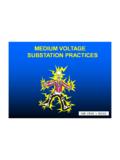Transcription of Bonding and Grounding Practice - Cenovus Energy
1 Operations Health & SafetyBonding and Grounding PracticeProgramSafe Work ManagementH&S DisciplineOccupational SafetyContent OwnerGroup Lead, Process Safety EngineeringStaff, Electrical SafetyCustodianH&S Programs & ProjectsDocument Cycle3 yearsRevised DateOctober 15, 2014 Issued dateMarch 16, 2004 Sign OffVersionDescriptionDateOriginator Reviewer(s) Approver(s) : Definitions References to industrystandards andregulatoryrequirements Overview of hazardsAdded: Section Roles andResponsibilities Section Trainingand Competency Section QualityAssuranceOct 2, 2014 Bonding and Grounding PracticeCEN-EHS030 | Version March 16, 2004 | Revised October 15, 2014 Uncontrolled when printed Cenovus | All rights reservedPage iiTable of and Grounding Identification, Assessment, and Hazards Bonding and Grounding and of and Grounding PracticeCEN-EHS030 | Version March 16, 2004 | Revised October 15, 2014 Uncontrolled when printed Cenovus | All rights reservedPage iiiList of TablesTable 1: Roles and 2: Terms and 3: Acronyms, Initialisms and 4: External Document 5.
2 Internal Document and Grounding PracticeCEN-EHS030 | Version March 16, 2004 | Revised October 15, 2014 Uncontrolled when printed Cenovus | All rights reservedPage 1 of Practice provides an overview of the requirements for Bonding and Grounding at Cenovus worksites. For information on Bonding and Grounding for the purposes of mitigating static accumulation, discharge and ignition of flammable fluids or vapours, see Flammable and Combustible Liquids Handling Practice (CEN-EHS8213).Should conflict arise between the requirements of this Practice and legislative requirements of an applicable jurisdiction, the more stringent requirements shall take Practice applies to all Cenovus worksites and encompasses all Bonding and Grounding activities within their scope of work.
3 Persons involved in operations, maintenance, and construction tasks at Cenovus worksites are required to understand and comply with this and Grounding LimitationsBonding and Grounding are important and require safeguards, but under some circumstances will not prevent static discharge and ignition of flammable vapours by static sparks. Bonding and Grounding alone does not provide adequate fire safety for flammable liquids transfer. For this, approved safety cans, dispensing devices and drum safety vents are required. For details, see Flammable and Combustible Liquids Handling Practice (CEN-EHS8213). Identification, Assessment, and ControlBusiness units must identify and assess the requirements for Bonding and Grounding in order to protect workers and facilities from hazards associated with the accumulation of static charge, work on or near to electrical installations, and lightning strikes.
4 Bonding and Grounding measures must be implemented as necessary and will comply with the requirements of the jurisdiction having authority. Hazards OverviewBonding and Grounding serves to mitigate electrical hazards associated with the Static Electric ChargeFlammable and explosive atmospheres and fluids found throughout the oil and gas industry may be ignited by sparks resulting from the discharge of static electricity. For example, static electricity may accumulate during the flow of fluid in piping or vessels, during fluid loading or offloading, or during the transfer of fluids between containers. Subsequent discharge of Bonding and Grounding PracticeCEN-EHS030 | Version March 16, 2004 | Revised October 15, 2014 Uncontrolled when printed Cenovus | All rights reservedPage 2 of 11static electricity can ignite the fluid.
5 This hazard is mitigated for fixed equipment by its engineered loading/offloading, fluid sampling, and fluid transfer between containers, Bonding and/or Grounding is often manually applied. Please see Flammable and Combustible Liquids Handling Practice (CEN-EHS8213) for more , workers can accumulate static charge on their body, which must be discharged in a controlled and deliberate manner, prior to entering buildings at production facilities. Workers are required to follow the Cenovus Well Site and Facility (Process Building) Entry Practice (CEN-EHS131). Contacting Tanks or Entering BuildingsIt is recommended to adhere to the following precautions:1. Ground by touching the building frame or piping when enteringbuildings that could contain flammable vapours.
6 Ground periodicallywhile working, especially if flammable gas/liquid vent points are in Be extremely cautious of contact with plastic tanks and other plasticcomponents as clothing may accumulate static charge, which could behazardous if discharged in a flammable environment. Ensure thatstatic electricity is dissipated harmlessly away from vapour sourcessuch as tank Enform Safety Alert 14-2012 Worker burned in methanol tank Static Electricity Hazard of FluidsThe static electricity hazard of fluids is a complex subject, however it is widely recognized that the conductivity of the fluid is a key factor. Nonconductive or poorly conductive fluids are prolific accumulators of static charge.
7 These fluids are also often flammable liquids and their vapours when mixed with air can form a flammable cloud or vapour space inside a tank or vessel. Some synthetic lubricants have been found to be very poor conductors and prolific accumulators of static electricity. Contamination of fluids may change the static electricity accumulation and/or flammable properties of the fluid, increasing the likelihood of a fire or the static electricity and/or flammability properties are unknown: Consider the fluid as being prone to electric charge accumulation andflammable Apply the Bonding and Grounding requirements as described in thisdocumentIn many cases, key information on the static electricity properties of fluids, notably conductivity, is not indicated on Material Safety Data Bonding and Grounding PracticeCEN-EHS030 | Version March 16, 2004 | Revised October 15, 2014 Uncontrolled when printed Cenovus | All rights reservedPage 3 of 11 Sheets (MSDS) and may not be published by the manufacturer.
8 In such cases it is necessary to do independent laboratory testing of the fluid to understand its static electricity properties. Filter Replacements on Screw Compressor Discharge SeparatorsStatic electricity discharge can be a hazard during replacement of filters inside screw compressor discharge separators. At least one flash fire has occurred during filter changes on this equipment (see Cenovus Technical Alert Hazards of static electric accumulation) when synthetic polyglycol lubricant was used. Filters are known to cause electric charge accumulation on lubricants and other fluids. While such fluids may not be inherently flammable, they can absorb flammable gases during compressor operations.
9 When the filter housing is opened, evolved gases will mix with air producing a flammable environment. Filter removal may generate a static spark if un-bonded metal components exist on the filter procedures for these filters should include sufficient time for static relaxation and ventilation of gases from the Electrical Equipment Bonding and Grounding requirements for the installation and maintenance of electrical equipment are detailed in the Canadian Electrical Code and other electrical installation codes in-force. Bonding and Grounding electrical equipment serves to safeguard workers from electric shock. Additionally, the requirements detailed in these codes serve to protect equipment and facilities from electrical fires and explosions.
10 Portable or re-locatable electrical equipment includes, but is not limited to, generators, light standards, ground thawers, and temporary power. All portable electrical equipment must be bonded to ground as per the manufacturer s instructions, and any site-specific portable appliances and power tools present a shock hazard when used outdoors, and in wet locations. All cord-connected portable appliances and tools shall be plugged-into an approved ground fault circuit interrupter (GFCI) receptacle. Battery-operated portable appliances and power tools present a shock hazard when used in wet locations, and therefore shall be used in accordance with the manufacturer s qualified electrical workers shall install and maintain electrical equipment.

